
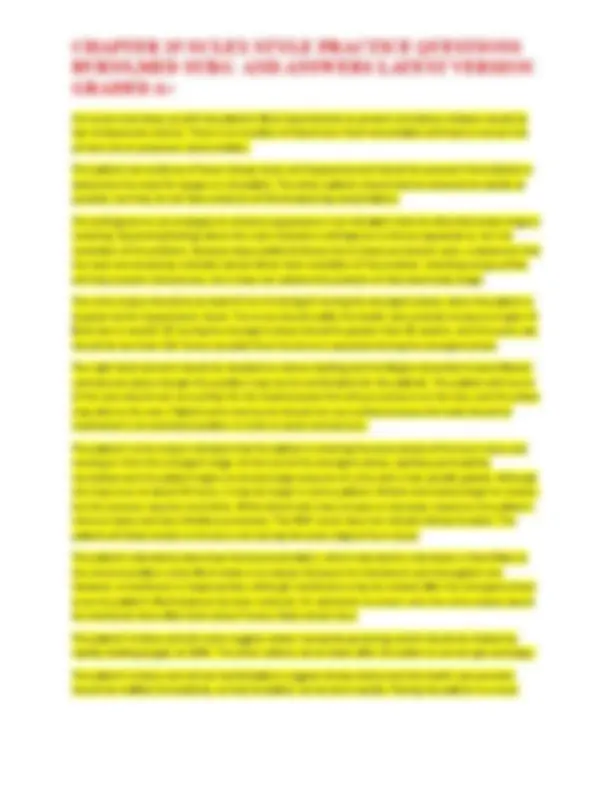
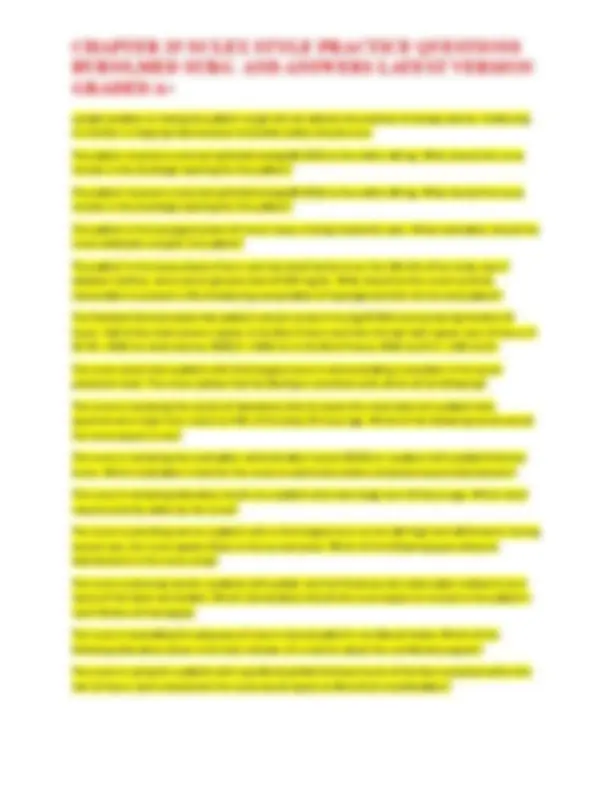
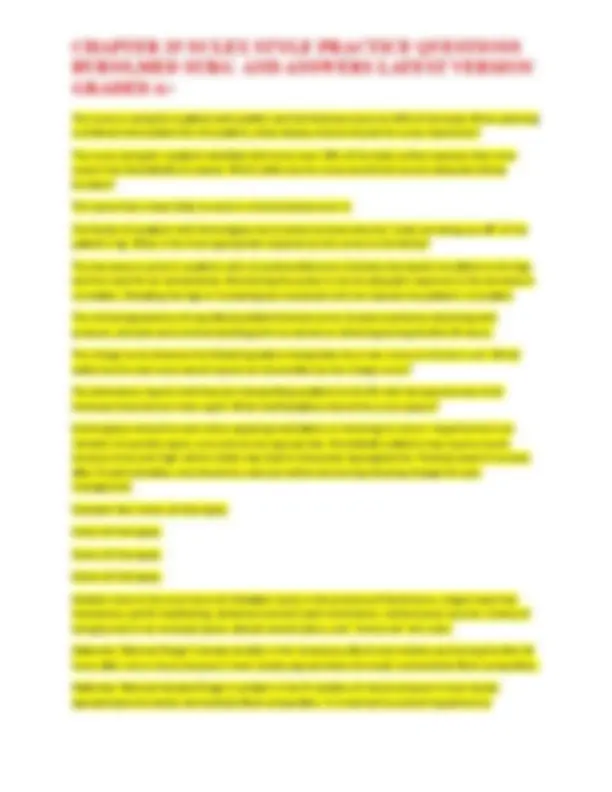
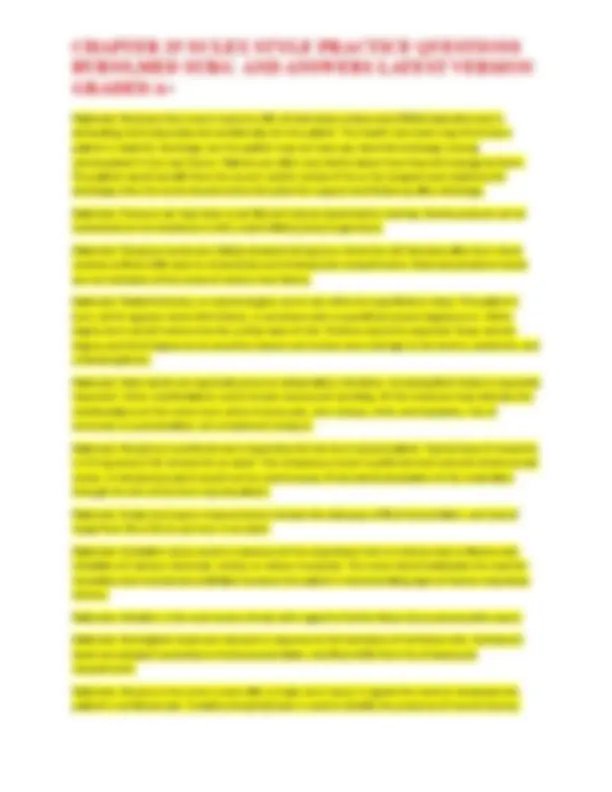
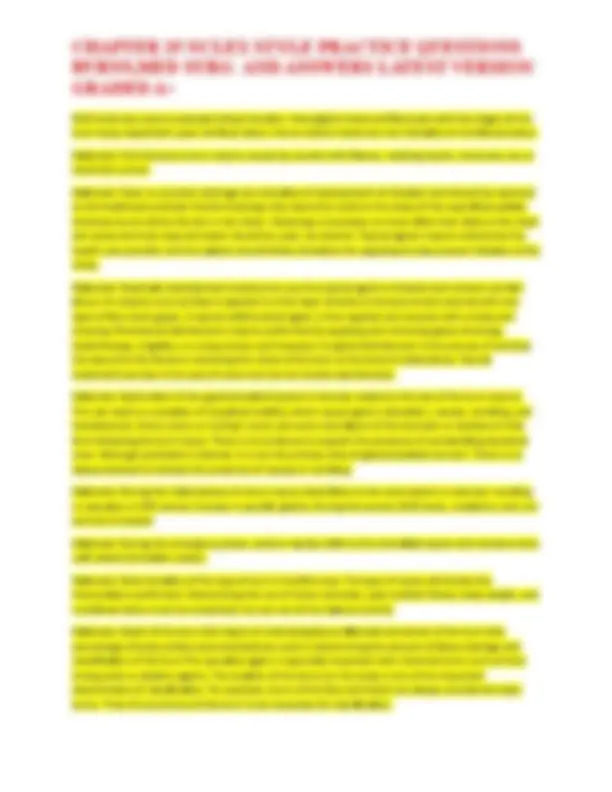
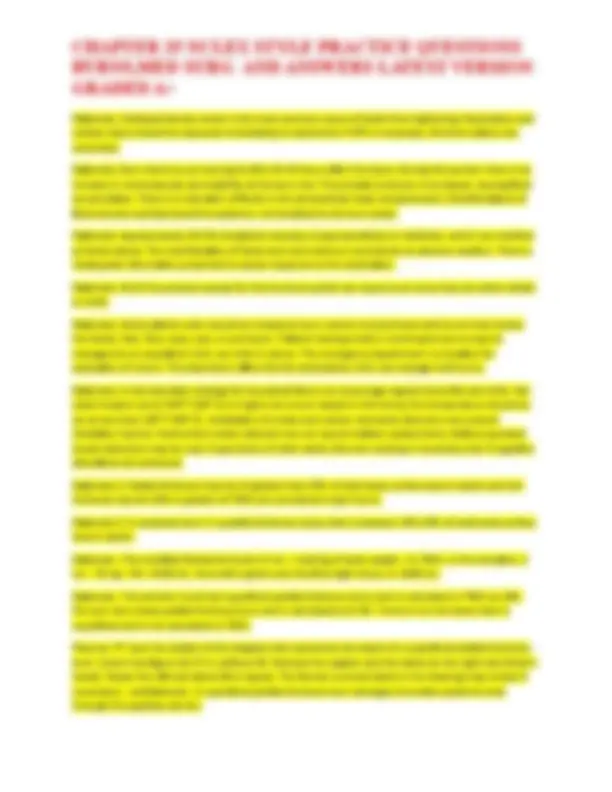
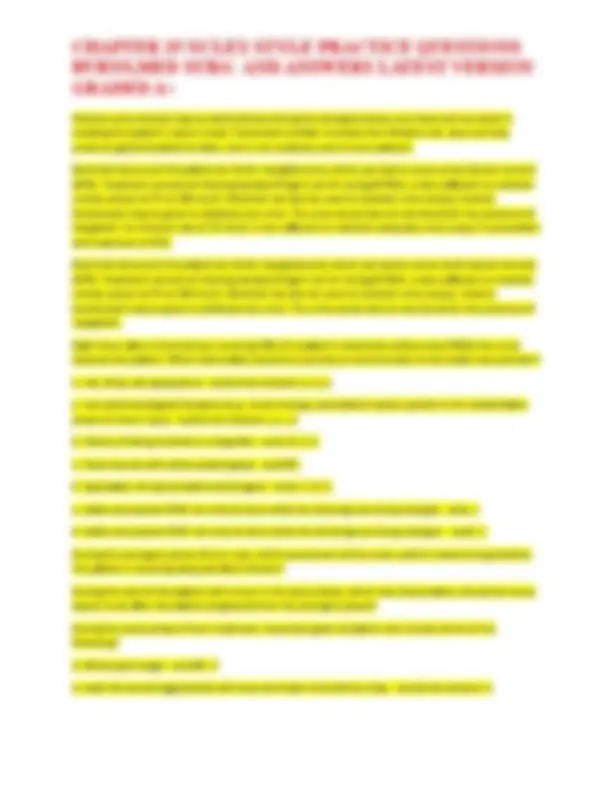
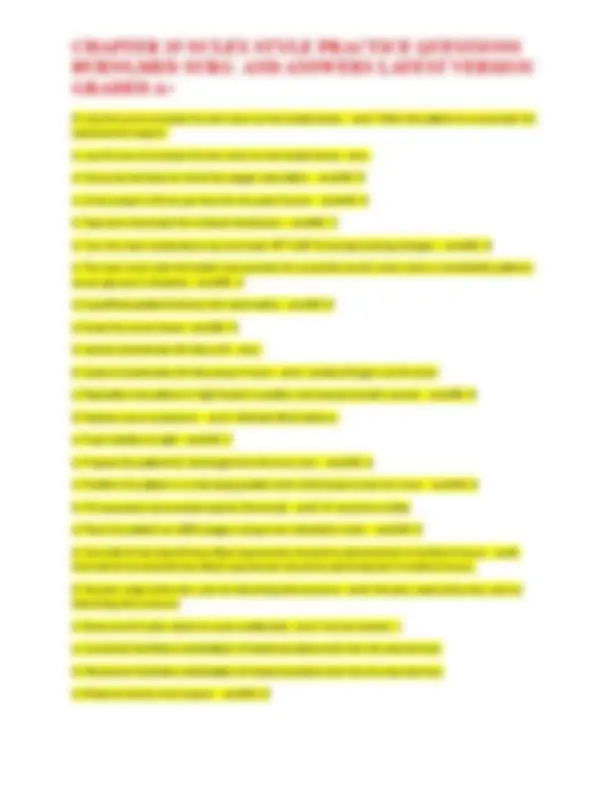
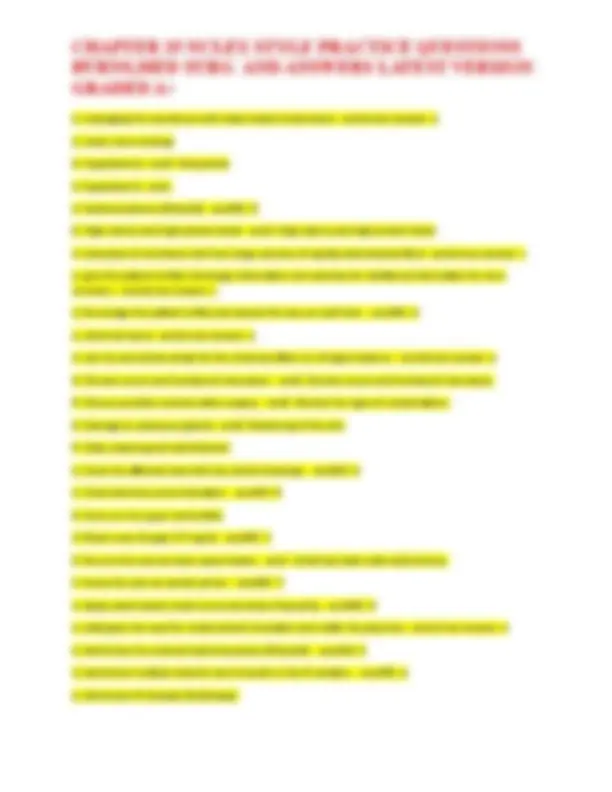
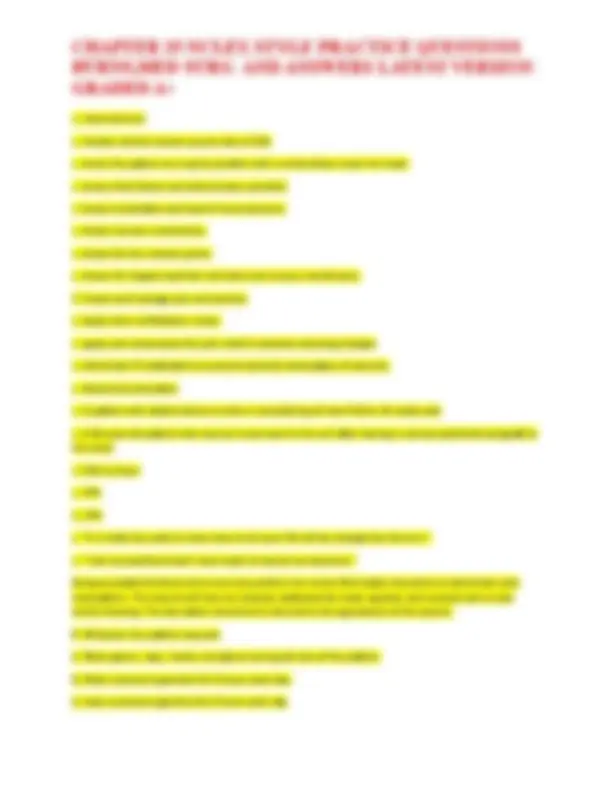
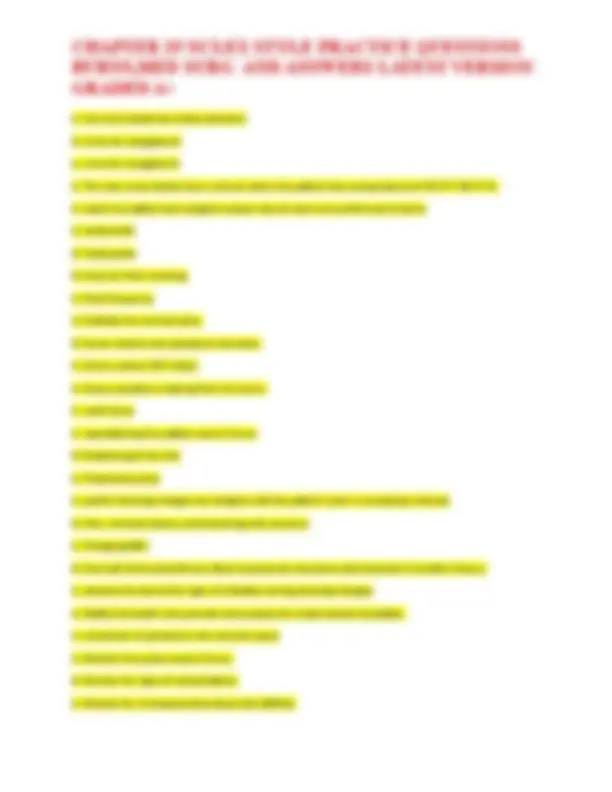
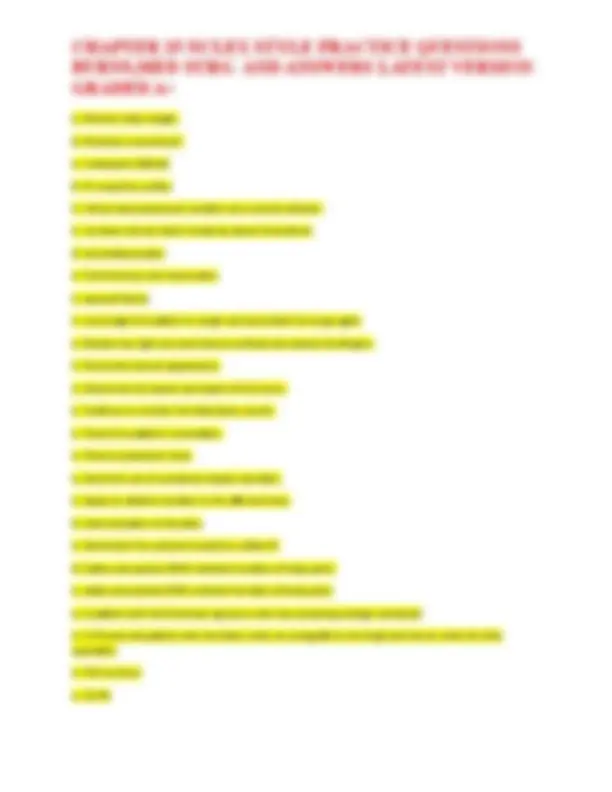
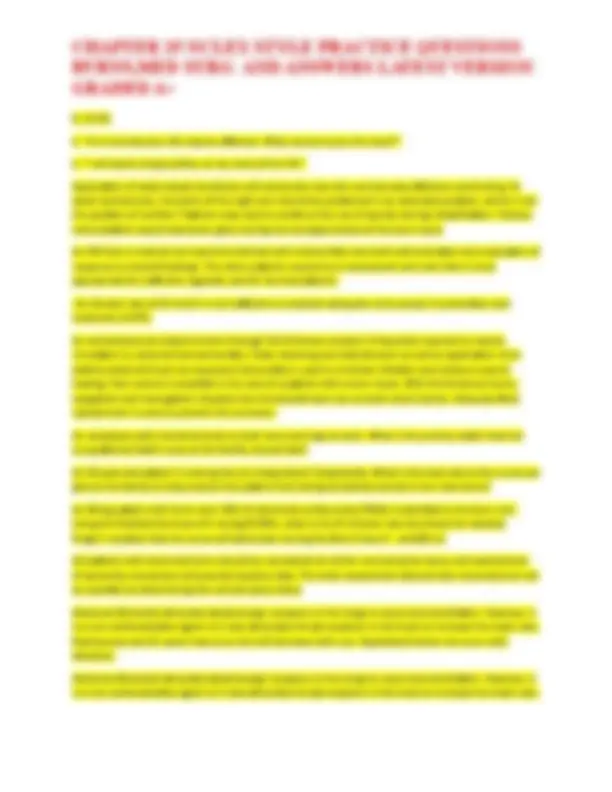
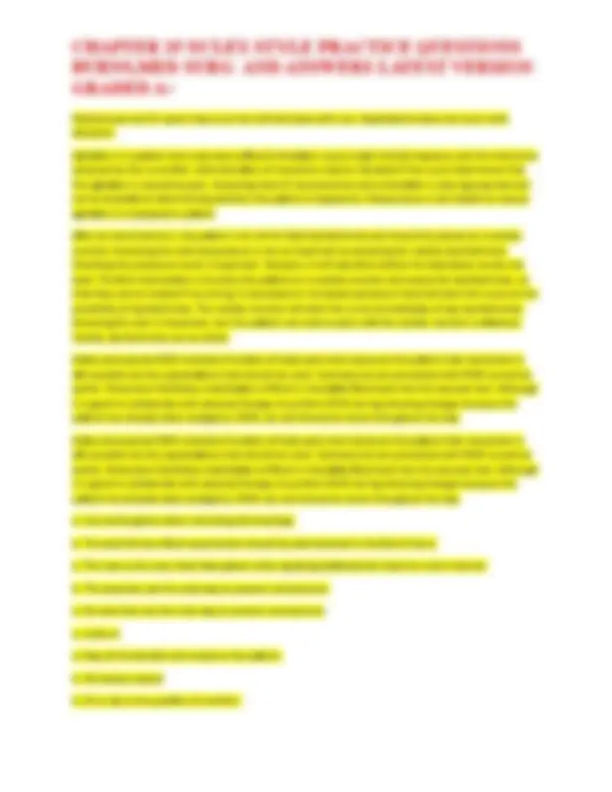
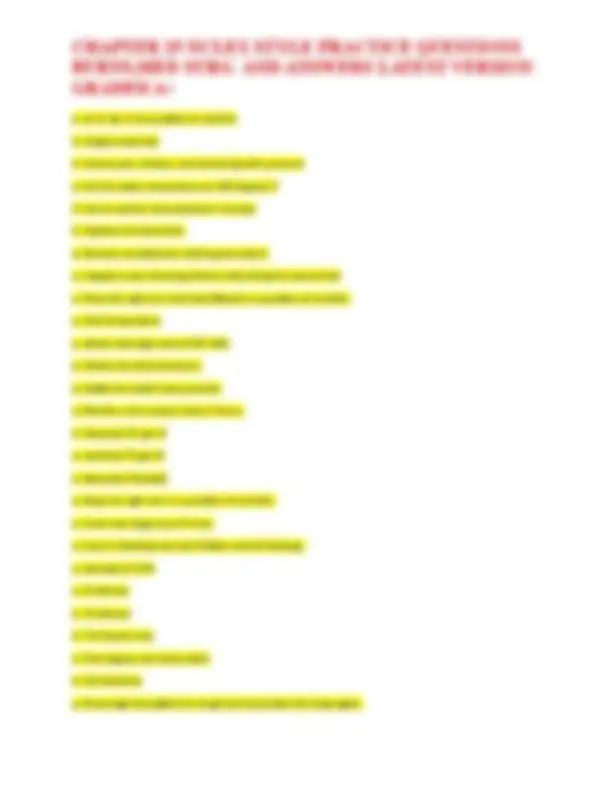
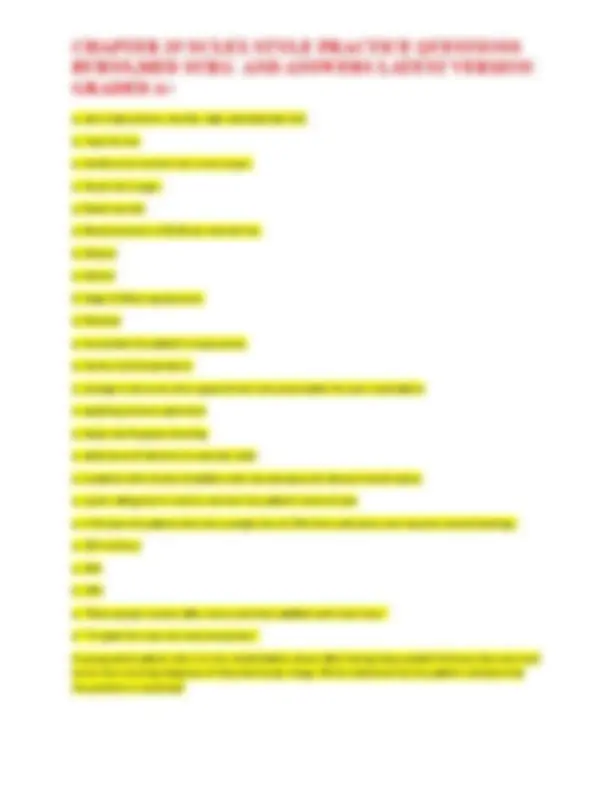
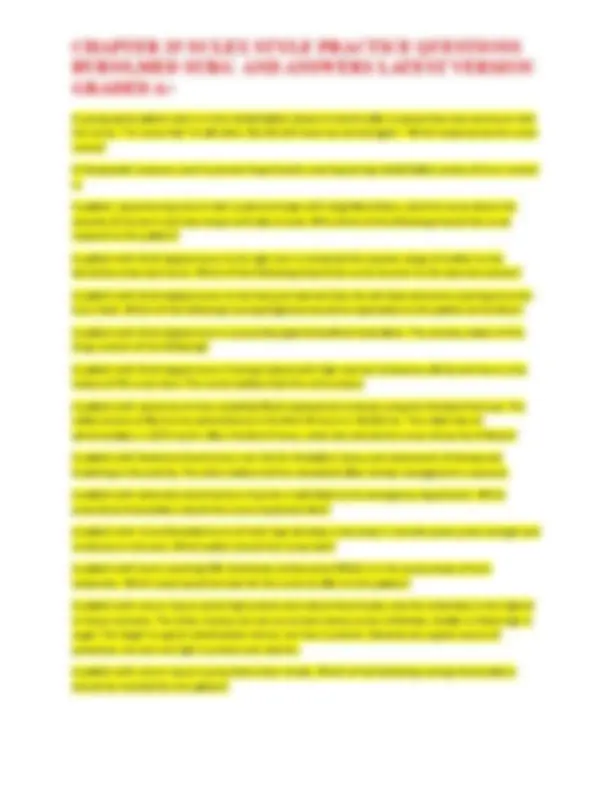
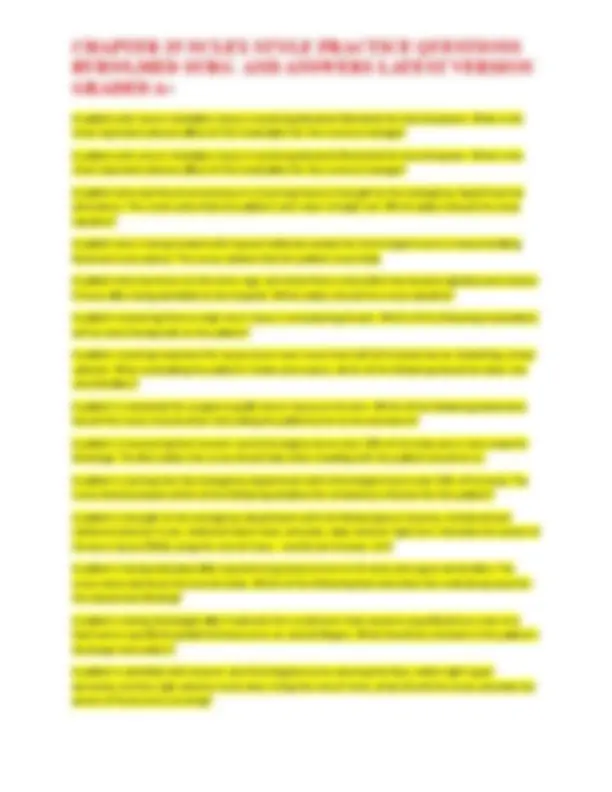
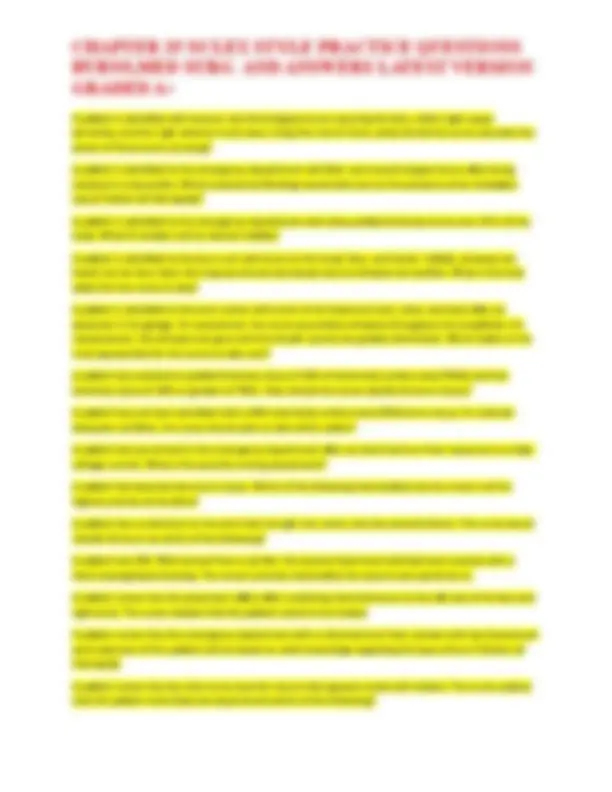
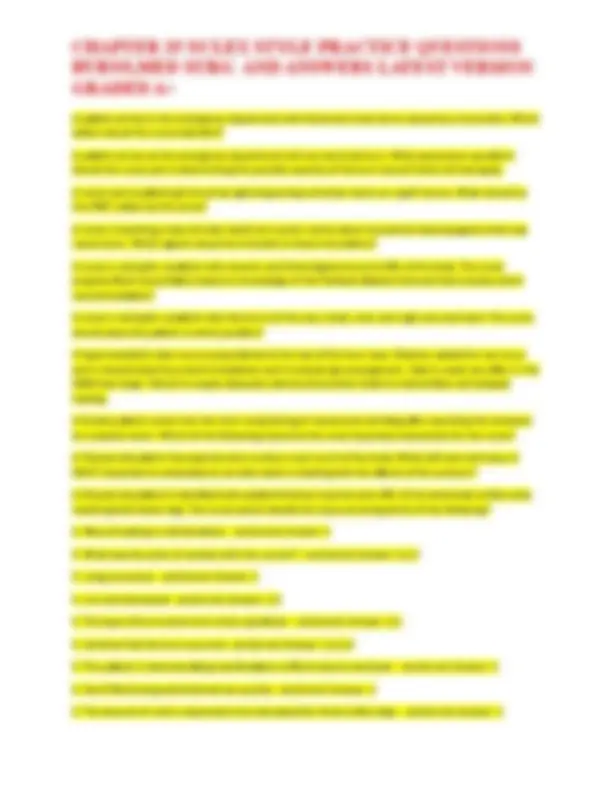
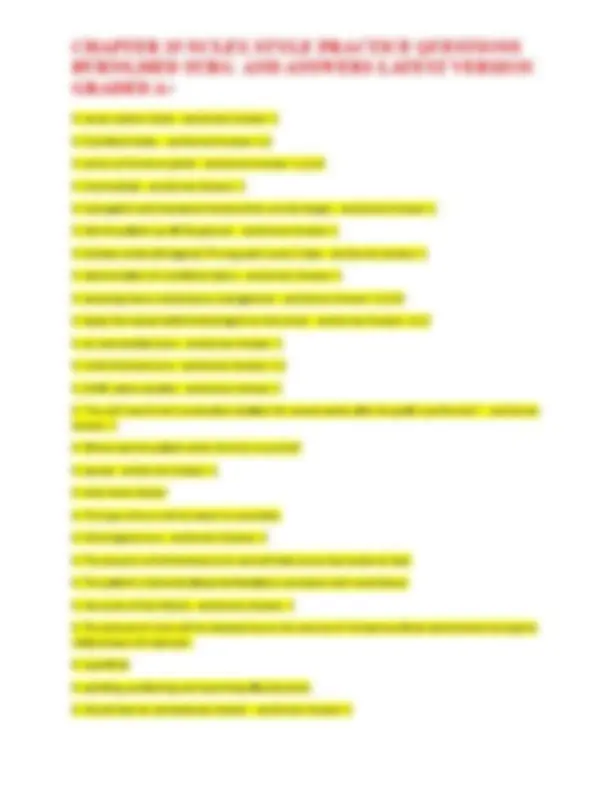
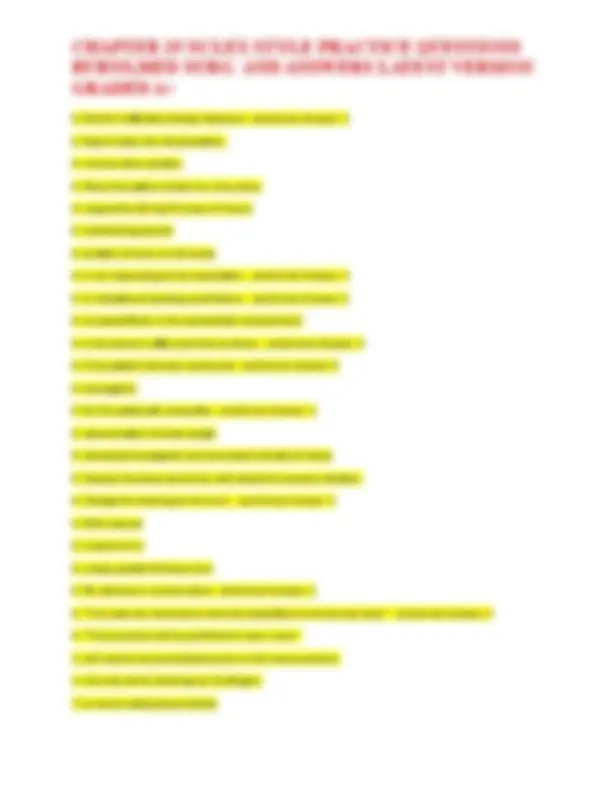
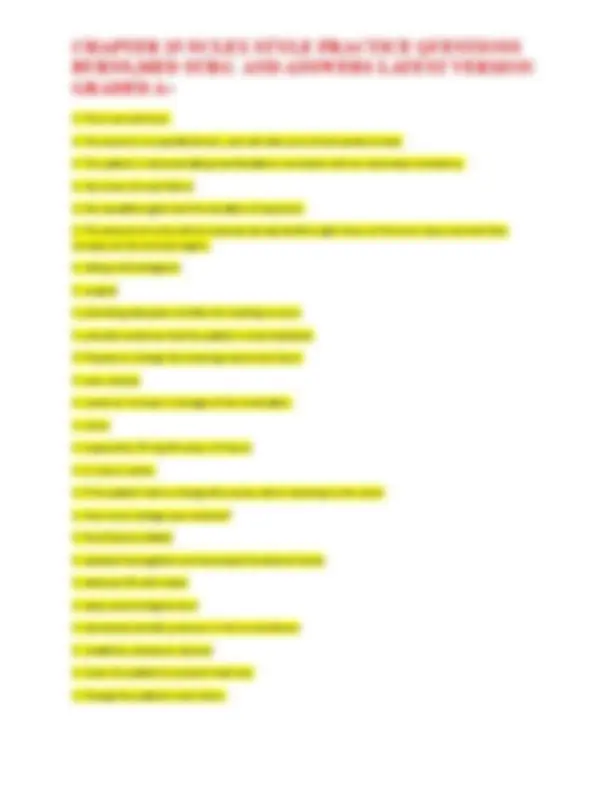
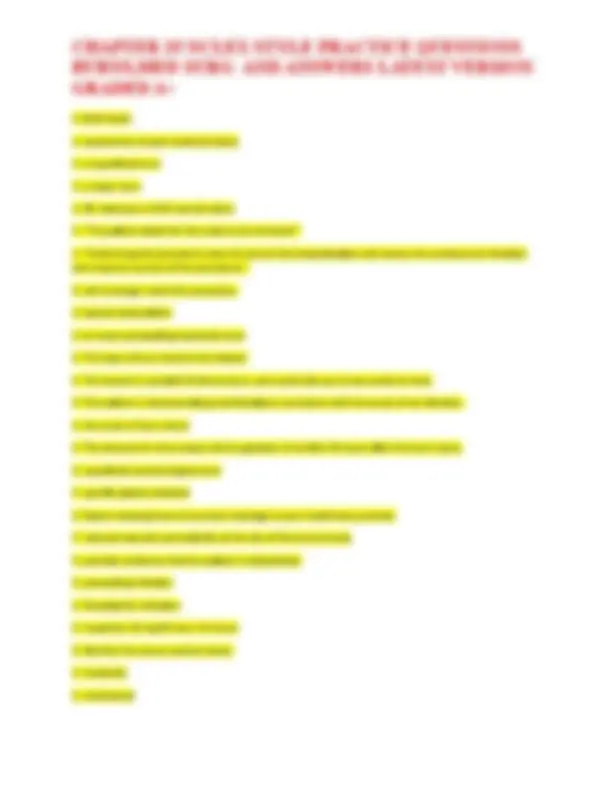
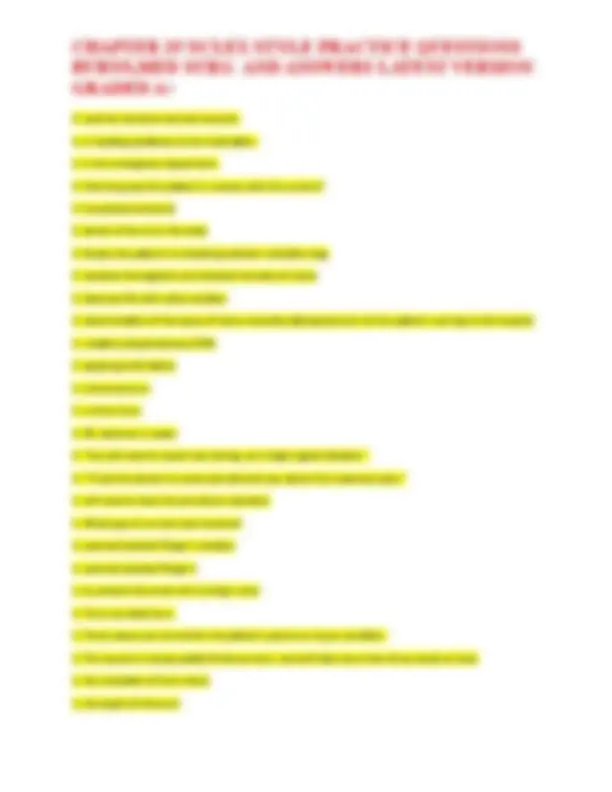
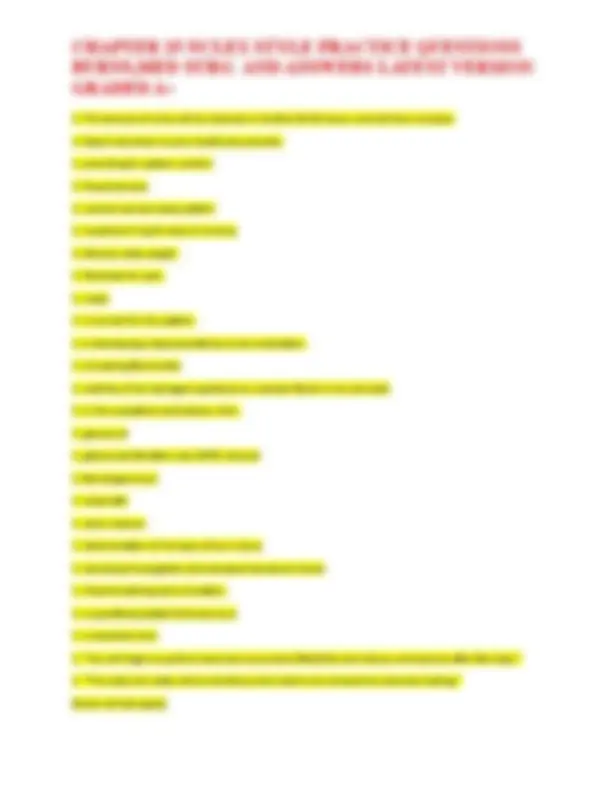
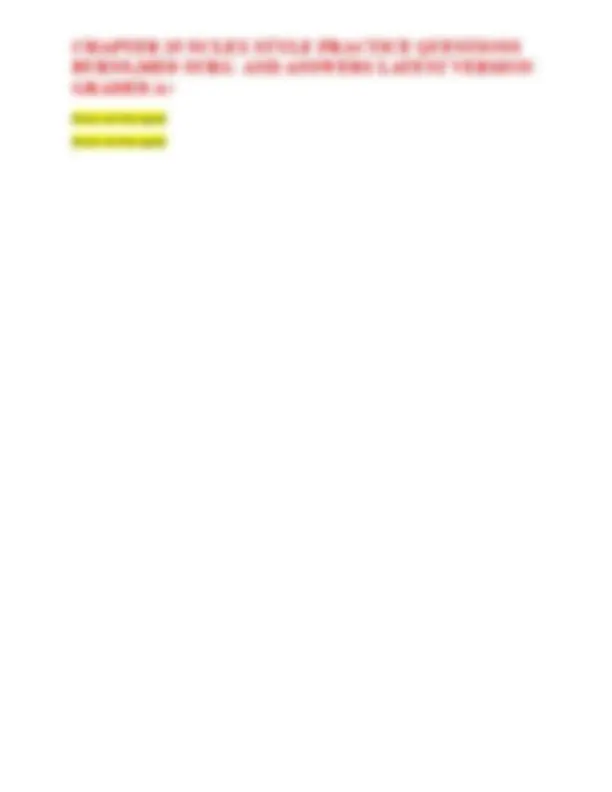








Study with the several resources on Docsity

Earn points by helping other students or get them with a premium plan


Prepare for your exams
Study with the several resources on Docsity

Earn points to download
Earn points by helping other students or get them with a premium plan
Community
Ask the community for help and clear up your study doubts
Discover the best universities in your country according to Docsity users
Free resources
Download our free guides on studying techniques, anxiety management strategies, and thesis advice from Docsity tutors
CHAPTER 25 NCLEX STYLE PRACTICE QUESTIONS BURNS,MED SURG AND ANSWERS LATEST VERSION GRADED A+.pdf
Typology: Exams
1 / 41

This page cannot be seen from the preview
Don't miss anything!


































With full-thickness skin destruction, the appearance is pale and dry or leathery and the area is painless because of the associated nerve destruction. Erythema, swelling, and blisters point to a deep partial- thickness burn. With superficial partial-thickness burns, the area is red, but no blisters are present. First- degree burns exhibit erythema, blanching, and pain With full-thickness burns, the nerves and vasculature in the dermis are destroyed so there is no pain, the tissue is dry and waxy-looking or may be charred, and there is no blanching with pressure. Severe pain, blisters, and blanching occur with partial-thickness (deep, second-degree) burns. Pain, minimal edema, blanching, and redness occur with partial-thickness (superficial, first-degree) burns. With chemical burns, the initial action is to remove the chemical from contact with the skin as quickly as possible. Remove nonadherent clothing, shoes, watches, jewelry, glasses, or contact lenses (if face was exposed). Flush chemical from wound and surrounding area with copious amounts of saline solution or water. Covering the affected area or placing cool compresses on the area will leave the chemical in contact with the skin. Application of an alkaline solution is not recommended. While the patient's full-thickness burn wounds to the face are exposed, what is the best nursing action to prevent cross contamination? Which patient should the nurse assess first? Which patient is most appropriate for the burn unit charge nurse to assign to a registered nurse (RN) who has floated from the hospital medical unit? Which nursing action is a priority for a patient who has suffered a burn injury while working on an electrical power line? Which action will the nurse include in the plan of care for a patient in the rehabilitation phase after a burn injury to the right arm and chest? When teaching the patient about the use of range-of-motion (ROM), what explanations should the nurse give to the patient? (select all that apply)? When teaching the patient about the use of range-of-motion (ROM), what explanations should the nurse give to the patient? Select all that apply. When monitoring the vital signs of the patient who has experienced a major burn injury, the nurse assesses a heart rate of 112 and a temperature of 99.9° F. Which of the following best describes the findings? When fluid intake is adequate, the urine output will be at least 0.5 to 1 mL/kg/hour. The patient's weight is not useful in this situation because of the effects of third spacing and evaporative fluid loss. Mucous membrane assessment and skin turgor also may be used, but they are not as adequate in determining that fluid infusions are maintaining adequate perfusion. When evaluating the laboratory values of the burn-injured patient, which of the following can be anticipated?
When caring for a patient with an electrical burn injury, which order from the health care provider should the nurse question? When caring for a patient with an electrical burn injury, which order from the health care provider should the nurse question? When assessing a patient with a partial-thickness burn, the nurse would expect to find (SATA): When assessing a patient who spilled hot oil on the right leg and foot, the nurse notes that the skin is dry, pale, hard skin. The patient states that the burn is not painful. What term would the nurse use to document the burn depth? Using the rule of nines, for these second- and third-degree burns, the face encompasses 4.5% of the body area, the entire right arm encompasses 9% of the body area, and the entire anterior trunk encompasses 18% of the body area. Since the patient has burns on only the right side of the anterior trunk, the nurse would assess that burn as encompassing half of the 18%, or 9%. Therefore adding the three areas together (4.5 + 9 + 9), the nurse would correctly calculate the extent of this patient's burns to cover approximately 22.5% of the total body surface area. Using the rule of nines, for these second- and third-degree burns, the face encompasses 4.5% of the body area, the entire right arm encompasses 9% of the body area, and the entire anterior trunk encompasses 18% of the body area. Since the patient has burns on only the right side of the anterior trunk, the nurse would assess that burn as encompassing half of the 18%, or 9%. Therefore adding the three areas together (4.5 + 9 + 9), the nurse would correctly calculate the extent of this patient's burns to cover approximately 22.5% of the total body surface area. Using the modified Brooke formula, calculate the amount of intravenous solution that will be administered in the first 8 hours for a patient with 40% TBSA and weighs 52 kg. - ansCorrect Answer: 2080 mL Use of gowns, caps, masks, and gloves during all patient care will decrease the possibility of wound contamination for a patient whose burns are not covered. When removing contaminated dressings and washing the dirty wound, use nonsterile, disposable gloves. The room temperature should be kept at approximately 85° F for patients with open burn wounds to prevent shivering. Systemic antibiotics are not well absorbed into deep burns because of the lack of circulation. To maintain a positive nitrogen balance in a major burn, the patient must: This response acknowledges the patient's feelings and asks for more assessment data that will help in developing an appropriate plan of care to assist the patient with the emotional response to the burn injury. The other statements are accurate, but do not acknowledge the anxiety and depression that the patient is expressing. This patient is most likely experiencing hyperosmolar hyperglycemic syndrome (HHS). HHS dehydrates a patient rapidly. Thus HHS combined with the massive fluid losses of a burn tremendously increase this patient's risk for hypovolemic shock and serious hypotension. This is clearly the nurse's priority because
upright position or having the patient cough will not address the problem of airway edema. Continuing to monitor is inappropriate because immediate action should occur The patient received a cultured epithelial autograft (CEA) to the entire left leg. What should the nurse include in the discharge teaching for this patient? The patient received a cultured epithelial autograft (CEA) to the entire left leg. What should the nurse include in the discharge teaching for this patient? The patient in the emergent phase of a burn injury is being treated for pain. What medication should the nurse anticipate using for this patient? The patient in the acute phase of burn care has electrical burns on the left side of her body, type 2 diabetes mellitus, and a serum glucose level of 485 mg/dL. What should be the nurse's priority intervention to prevent a life-threatening complication of hyperglycemia for this burned patient? The Parkland formula states that patients should receive 4 mL/kg/%TBSA burned during the first 24 hours. Half of the total volume is given in the first 8 hours and then the last half is given over 16 hours: 4 80 30 = 9600 mL total volume; 9600/2 = 4800 mL in the first 8 hours; 4800 mL/8 hr = 600 mL/hr. The nurse notes that a patient with third-degree burns is demonstrating a reduction in his serum potassium level. The nurse realizes that this finding is consistent with which of the following? The nurse is reviewing the results of laboratory tests to assess the renal status of a patient who experienced a major burn event on 45% of the body 24 hours ago. Which of the following results would the nurse expect to see? The nurse is reviewing the medication administration record (MAR) on a patient with partial-thickness burns. Which medication is best for the nurse to administer before scheduled wound debridement? The nurse is reviewing laboratory results on a patient who had a large burn 48 hours ago. Which result requires priority action by the nurse? The nurse is providing care to a patient with a third-degree burn on his left thigh and left forearm. During wound care, the nurse applies Elase to the burned areas. Which of the following types ofwound debridement is this nurse using? The nurse is planning care for a patient with partial- and full-thickness skin destruction related to burn injury of the lower extremities. Which interventions should the nurse expect to include in this patient's care? (Select all that apply.) The nurse is evaluating the adequacy of a burn-injured patient's nutritional intake. Which of the following laboratory values is the best indicator of a need to adjust the nutritional program? The nurse is caring for a patient with superficial partial-thickness burns of the face sustained within the last 12 hours. Upon assessment the nurse would expect to find which manifestation?
The nurse is caring for a patient with partial- and full-thickness burns to 65% of the body. When planning nutritional interventions for this patient, what dietary choices should the nurse implement? The nurse caring for a patient admitted with burns over 30% of the body surface assesses that urine output has dramatically increased. Which action by the nurse would best ensure adequate kidney function? The injury that is least likely to result in a full-thickness burn is: The family of a patient with third-degree burns wants to know why the "scabs are being cut off" of the patient's leg. What is the most appropriate response by the nurse to this family? The decrease in pulse in a patient with circumferential burns indicates decreased circulation to the legs and the need for an escharotomy. Monitoring the pulses is not an adequate response to the decrease in circulation. Elevating the legs or increasing toe movement will not improve the patient's circulation The clinical appearance of superficial partial-thickness burns includes erythema, blanching with pressure, and pain and minimal swelling with no vesicles or blistering during the first 24 hours. The charge nurse observes the following actions being taken by a new nurse on the burn unit. Which action by the new nurse would require an intervention by the charge nurse? The ambulance reports that they are transporting a patient to the ED who has experienced a full- thickness thermal burn from a grill. What manifestations should the nurse expect? Sterile gloves should be worn when applying medications or dressings to a burn. Hypothermia is an indicator of possible sepsis, and cultures are appropriate. Nondiabetic patients may require insulin because stress and high calorie intake may lead to temporary hyperglycemia. Fentanyl peaks 5 minutes after IV administration, and should be used just before and during dressing changes for pain management Standard Text: Select all that apply. Select all that apply. Select all that apply. Select all that apply. Reliable clues to the occurrence of inhalation injury is the presence of facial burns, singed nasal hair, hoarseness, painful swallowing, darkened oral and nasal membranes, carbonaceous sputum, history of being burned in an enclosed space, altered mental status, and "cherry red" skin color. Rationale: Warmed Ringer's lactate solution is the intravenous fluid most widely used during the first 24 hours after a burn injury because it most closely approximates the body's extracellular fluid composition. Rationale: Warmed lactated Ringer's solution is the IV solution of choice because it most closely approximates the body's extracellular fluid composition. It is warmed to prevent hypothermia.
increased gluconeogenesis. Failure to supply adequate calories and protein leads to malnutrition and delays in healing. Rationale: The nurse should anticipate this patient's needs for analgesia and administer pain medication to promote the patient's comfort during the exercise session. Arm exercise is not related to the amount of urine in the catheter bag. Linen changes do not impact range of motion activities. The burn's dressing is changed according to the physician's orders or as needed. Rationale: The goals of treatment for the acute period include wound cleansing and healing; pain relief; preventing infection; promoting nutrition; and splinting, positioning, and exercising affected joints. Assessment of home maintenance management is an important goal in the rehabilitative stage, not the acute stage. Rationale: The burn-injured patient is not considered tachycardic until the heart rate reaches 120 beats per minute. In the absence of other symptoms, the temperature does not signal the presence of an infection. It could be a response to a hypermetabolic response. Rationale: The appearance of partial-thickness (deep) burns may include fluid-filled vesicles (blisters) that are red, shiny, or wet (if vesicles have ruptured). Patients may have severe pain caused by exposure of nerve endings and may have mild to moderate edema. Rationale: Surgical debridement is the process of excising the burn wound by removing thin slices of the wound to the level of viable tissue. If bleeding does not occur after the procedure, it will be repeated. It is an assumption that patients having debridement will all require premedication. An escharotomy involves removal of the hardened crust covering the burned area. Rationale: Superficial partial-thickness burn if often bright red, has a moist, glistening appearance and blister formation. Thermal burns result from exposure to dry or moist heat. A superficial burn is reddened with possible slight edema over the area. A deep partial-thickness burn often appears waxy and pale and may be moist or dry. A full-thickness burn may appear pale, waxy, yellow, brown, mottled, charred, or non-blanching red with a dry, leathery, firm wound surface. Rationale: Sunburns result from exposure to ultraviolet light. Because the skin remains intact, the manifestations in most cases are mild and are limited to pain, nausea, vomiting, skin redness, chills, and headache. The patient has not reported concerns which will support issues with sleep pattern, diet, and travel. Rationale: Silver nitrate can cause hypotonicity. Manifestations of hypotonicity include weight gain and edema, which can be monitored by the determination of daily weights. Hyponatremia and hypochloremic alkalosis are common findings in patients treated with silver nitrate so serum sodium and chloride should be monitored. Changing the dressing every two hours is too frequent for the patient. Black discolorations of the skin are anticipated for patients using silver nitrate, and do not highlight a complication of therapy. Silver sulfadiazine, not silver nitrate, administration can result in the development of sulfa crystals in the urine so pushing fluid intake is not an appropriate action for this patient.
Rationale: Recovery from a burn injury to 30% of total body surface area (TBSA) takes time and is exhausting, both physically and emotionally, for the patient. The health care team may think that a patient is ready for discharge, but the patient may not have any idea that discharge is being contemplated in the near future. Patients are often very fearful about how they will manage at home. The patient would benefit from the nurse's careful review of his or her progress and readiness for discharge; then the nurse should outline the plans for support and follow-up after discharge. Rationale: Pressure can help keep a scar flat and reduce hypertrophic scarring. Gentle pressure can be maintained on the healed burn with custom-fitted pressure garments. Rationale: Potassium levels are initially elevated during burn shock but will decrease after burn shock resolves as fluid shifts back to intracellular and intravascular compartments. Reduced potassium levels are not indicators of the onset of renal or liver failure. Rationale: Partial-thickness, or second-degree, burns can either be superficial or deep. This patient's burn, which appears moist with blisters, is consistent with a superficial second-degree burn. A first- degree burn would involve only the surface layer of skin. Redness would be expected. Deep second- degree and third-degree burns would be deeper and involve more damage to the dermis, epidermis, and underlying tissue. Rationale: Older adults are especially prone to dehydration; therefore, increasing fluid intake is especially important. Other manifestations could include nausea and vomiting. All the measures help alleviate the manifestations of this minor burn which include pain, skin redness, chills, and headache. Use of sunscreen is a preventative, not a treatment measure. Rationale: Morphine is preferred over meperidine for the burn-injured patient. Typical dose of morphine is 3-5 mg every 5-10 minutes for an adult. The intravenous route is preferred over oral and intramuscular routes. A transdermal patch would not be used because of decreased absorption of the medication through the skin of the burn-injured patient. Rationale: Intake and output measurements indicate the adequacy of fluid resuscitation, and should range from 30 to 50 mL per hour in an adult. Rationale: Inhalation injury results in exposure of the respiratory tract to intense heat or flames with inhalation of noxious chemicals, smoke, or carbon monoxide. The nurse should anticipate the need for intubation and mechanical ventilation because this patient is demonstrating signs of severe respiratory distress. Rationale: Infection is the most serious threat with regard to further tissue injury and possible sepsis. Rationale: Hemoglobin levels are reduced in response to the hemolysis of red blood cells. Hematocrit levels are elevated secondary to hemoconcentration, and fluid shifts from the intravascular compartment. Rationale: Glucose in the urine is seen after a major burn injury. It signals the need to reevaluate the patient's nutritional plan. Creatine phosphokinase is used to identify the presence of muscle injuries.
Rationale: Cardiopulmonary arrest is the most common cause of death from lightening. Respiratory and cardiac status should be assessed immediately to determine if CPR is necessary. All other actions are secondary. Rationale: Burn shock occurs during the first 24-36 hours after the injury. During this period, there is an increase in microvascular permeability at the burn site. The osmotic pressure is increased, causing fluid accumulation. There is a reduction of fluids in the extracellular body compartments. Manifestations of fluid volume overload would be systemic, not localized to the burn areas. Rationale: Approximately 3%-5% of patients develop a hypersensitivity to mafenide, which can manifest as facial edema. The manifestation of facial and neck edema is considered an adverse reaction. There is inadequate information presented to assess response to the medication. Rationale: All of the products except for the furniture polish can cause burns since they are either alkalis or acids. Rationale: Adult patients who should be treated at burn centers include those with burns that involve the hands, feet, face, eyes, ears, or perineum. Patients having small or noninvasive burns may be managed at an outpatient clinic are mild in nature. The emergency department is a location for evaluation of a burn. The physician's office like the ambulatory clinic can manage mild burns. Rationale: A risk-reduction strategy for household fires is to encourage regular home fire exit drills. Hot water heaters set at 140° F (60° C) or higher are a burn hazard in the home; the temperature should be set at less than 120° F (40° C). Installation of smoke and carbon monoxide detectors can prevent inhalation injuries. Hard-wired smoke detectors do not require battery replacement; battery-operated smoke detectors may be used. Supervision of older adults who are cooking is necessary only if cognitive alterations are observed. Rationale 1: Partial-thickness injuries of greater than 25% of total body surface area in adults and full- thickness injuries 10% or greater of TBSA are considered major burns. Rationale 1: A moderate burn is a partial-thickness injury that is between 15%-25% of total body surface area in adults. Rationale : The modified Brooke formula is 2 mL × total kg of body weight × % TBSA. In this situation, 2 mL × 52 kg × 40 = 4160 mL. One-half is given over the first eight hours, or 2080 mL. Rationale : The anterior trunk has superficial partial-thickness burns and is calculated in TBSA as 18%. The arm has a deep partial-thickness burn and is calculated as 4.5%. The burn on the lower back is superficial and is not calculated in TBSA. Place an "X" over the section of the diagram that represents the depth of a superficial partial-thickness burn. [insert Use figure 16-17 in LeMone 5E. Remove the caption and the labels on the right side (Clark's levels). Retain the left side labels (Skin layers). The Roman numeral labels in the drawing may remain if necessary.] - ansRationale : A superficial partial-thickness burn damages the entire epidermis and through the papillary dermis.
Pain management for the burn patient is most effective when (SATA): Opioid pain medications are the best choice for pain control. The other medications are used as adjuvants to enhance the effects of opioids. On admission to the burn unit, a patient with an approximate 25% total body surface area (TBSA) burn has the following initial laboratory results: Hct 58%, Hgb 18.2 mg/dL (172 g/L), serum K+ 4.9 mEq/L (4. mmol/L), and serum Na+ 135 mEq/L (135 mmol/L). Which action will the nurse anticipate taking now? Monitoring for complications (e.g., wound infection, pneumonia, contractures) is needed in the acute phase. Fluid replacement occurs in the emergent phase. Assessing and managing pain and anxiety occurs in the emergent and the acute phases. Discussing possible reconstructive surgeries is done in the rehabilitation phase. Knowing the most common causes of household fires, which prevention strategy would the nurse focus on when teaching about fire safety? IV medications are used for burn injuries in the emergent phase to rapidly deliver relief and prevent unpredictable absorption as would occur with the IM route. The PO route is not used because GI function is slowed or impaired due to shock or paralytic ileus, although oxycodone and acetaminophen may be used later in the patient's recovery. Tetanus toxoid may be administered but not for pain. Installing tap water anti-scald devices will help prevent accidental scald burns that more easily occur in older people as their skin becomes drier and the dermis thinner. Cooking for her may be needed at times of illness or in the future, but she is moving to an independent living facility, so at this time she should not need this assistance. Stopping her from smoking may be helpful to prevent burns but may not be possible without the requirement by the facility. Using an open space heater would increase her risk of being burned and would not be encouraged. In which order will the nurse take these actions when doing a dressing change for a partial-thickness burn wound on a patient's chest? (Put a comma and a space between each answer choice [A, B, C, D, E].) In the rehabilitation phase, the patient will work toward resuming a functional role in society, but frequently there are body image concerns and grieving for the loss of the way they looked and functioned before the burn, so continued counseling helps the patient in this phase as well. Putting the leg in the position of comfort is more likely to lead to contractures than to help the patient. If a pressure garment is prescribed, it is used for 24 hours per day for as long as 12 to 18 months. Sunlight should be avoided to prevent injury, and sunscreen should always be worn when the patient is outside. In the rehabilitation phase, the patient will work toward resuming a functional role in society, but frequently there are body image concerns and grieving for the loss of the way they looked and functioned before the burn, so continued counseling helps the patient in this phase as well. Putting the leg in the position of comfort is more likely to lead to contractures than to help the patient. If a pressure garment is prescribed, it is used for 24 hours per day for as long as 12 to 18 months. Sunlight should be avoided to prevent injury, and sunscreen should always be worn when the patient is outside.
Vitamins and minerals may be administered during the emergent phase, but these will not assist in meeting the patient's caloric needs. Parenteral nutrition increases the infection risk, does not help preserve gastrointestinal function, and is not routinely used in burn patients. Electrical injury puts the patient at risk for myoglobinuria, which can lead to acute renal tubular necrosis (ATN). Treatment consists of infusing lactated Ringer's at 2-4 mL/kg/%TBSA, a rate sufficient to maintain urinary output at 75 to 100 mL/hr. Mannitol can also be used to maintain urine output. Sodium bicarbonate may be given to alkalinize the urine. The urine would also be monitored for the presence of myoglobin. An infusion rate of 25 mL/hr is not sufficient to maintain adequate urine output in prevention and treatment of ATN. Electrical injury puts the patient at risk for myoglobinuria, which can lead to acute renal tubular necrosis (ATN). Treatment consists of infusing lactated Ringer's at 2-4 mL/kg/%TBSA, a rate sufficient to maintain urinary output at 75 to 100 mL/hr. Mannitol can also be used to maintain urine output. Sodium bicarbonate may be given to alkalinize the urine. The urine would also be monitored for the presence of myoglobin. Eight hours after a thermal burn covering 50% of a patient's total body surface area (TBSA) the nurse assesses the patient. Which information would be a priority to communicate to the health care provider? e. red, shiny, wet appearance - ansCorrect answers: a, d, e e. non-pharmacological therapies (e.g., music therapy, distraction) replace opioids in the rehabilitation phase of a burn injury - ansCorrect answers: a, c, d E. History of being involved in a large fire - ansA, B, C, E. e. Clean wound with saline-soaked gauze - ansANS: E. Application of topical antimicrobial agent - ansA, C, D, E. e. active and passive ROM can only be done while the dressings are being changed - ansb, c E. Active and passive ROM can only be done while the dressings are being changed. - ansB, C. During the emergent phase of burn care, which assessment will be most useful in determining whether the patient is receiving adequate fluid infusion? During the care of the patient with a burn in the acute phase, which new interventions should the nurse expect to do after the patient progressed from the emergent phase? During the acute phase of burn treatment, important goals of patient care include which of the following? d. Whole grain bagel - ansANS: C d. wash the wound aggressively with soap and water three times a day. - ansCorrect answer: b
D. Use the sun to increase the skin color on the healed areas. - ansC. Refer the patient to a counselor for psychosocial support. d. use the sun to increase the skin color on the healed areas - ansc. d. Use pulse oximetry to check the oxygen saturation. - ansANS: D d. Urine output is 20 mL per hour for the past 2 hours. - ansANS: D d. Type and crossmatch for a blood transfusion. - ansANS: C d. Turn the room temperature up to at least 70° F (20° C) during dressing changes. - ansANS: B d. The new nurse calls the health care provider for a possible insulin order when a nondiabetic patient's serum glucose is elevated. - ansANS: A d. Superficial partial-thickness skin destruction - ansANS: B d. Stools for occult blood - ansANS: D d. sodium bicarbonate 24 mEq q.4h - ansc. D. Sodium bicarbonate 24 mEq every 4 hours - ansC. Lactated Ringer's at 25 mL/hr d. Reposition the patient in high-Fowler's position and reassess breath sounds. - ansANS: B D. Replace serum potassium. - ansC. Maintain fluid balance. d. Pupil reaction to light - ansANS: C d. Prepare the patient for discharge from the burn unit. - ansANS: A d. Position the patient in a side-lying position with rolled towel under the neck. - ansANS: B D. PO oxycodone and acetaminophen (Percocet) - ansB. IV morphine sulfate d. Place the patient on 100% oxygen using a non-rebreather mask. - ansANS: D D. One half of the total 24-hour fluid requirement should be administered in the first 4 hours. - ansB. One half of the total 24-hour fluid requirement should be administered in the first 8 hours. D. No pain, waxy white skin, and no blanching with pressure - ansD. No pain, waxy white skin, and no blanching with pressure d. Never permit older adults to cook unattended - ans1. Correct answer: c d. movement facilitates mobilization of leaked exudates back into the vascular bed. D. Movement facilitates mobilization of leaked exudates back into the vascular bed. d. Measure hourly urine output. - ansANS: D
d. A patient with 40% total body surface area (TBSA) burns who is receiving IV fluids at 500 mL/hour - ansANS: A d. a multi-modal approach is used (e.g., sustained-release and short-acting opioids, NSAIDS, adjuvant analgesics). d. A 65-year-old patient who has twice-daily burn debridements and dressing changes to partial- thickness facial burns - ansANS: A D. 36% - ansB. 22.5% d. 36% - ansb. d. 1250 mL/hour - ansANS: C d. "Why do you feel that way? You will be able to adapt as your recovery progresses." - ansANS: B d. "Do you think dark beige makeup foundation would cover this scar on my cheek?" - ansANS: D D, E, C, A, B Cervical spine injuries are commonly associated with electrical burns. Therefore stabilization of the cervical spine takes precedence after airway management. The other actions are also included in the emergent care after electrical burns, but the most important action is to avoid spinal cord injury. c. Vanilla milkshake c. the patient is informed about and has some control over the management of the pain c. The new nurse administers PRN fentanyl (Sublimaze) IV to a patient 5 minutes before a dressing change. c. Teach about the purpose of tetanus immunization. c. Serum potassium 6.1 mEq/L c. sequestering of sodium and water in interstitial fluid C. ROM will show the patient that movement is still possible. c. ROM will show the patient that movement is still possible c. review the patient's current health care status and readiness for discharge to home c. restlessness C. Restlessness C. Refer the patient to a counselor for psychosocial support. c. refer the patient to a counselor for phychosocial support
C. Redness, evidence of inhalation injury, and charred skin c. Place on cardiac monitor. c. Place cool compresses on the area of exposure. c. performing active ROM at least every 4 hours C. Painful swallowing C. One third of the total 24-hour fluid requirement should be administered in the first 4 hours. C. Maintain fluid balance. c. LR at 25 mL/h C. Lactated Ringer's at 25 mL/hr C. IV and oral pain medications C. Install tap water anti-scald devices. c. Infuse the ordered lactated Ringer's solution. c. Increase the rate of the ordered IV solution. C. IM hydromorphone (Dilaudid) C. High-protein and low-sodium foods c. Gabapentin (Neurontin) c. Extremity movement c. exposed muscles c. Encourage regular home fire exit drills c. Encourage an oral intake of at least 5000 kcal per day. c. Elevate both legs above heart level with pillows. C. Edema and arterial blood gases improve. c. eat at least 1500 calories/day in small, frequent meals c. Document the results and continue to monitor the patient's respiratory rate. c. document the findings and continue to monitor the patient's breathing C. Destruction of all skin layers c. Deep partial-thickness skin destruction
b. Use only hardwired smoke detectors B. Urine for myoglobulin b. urine for myoglobulin b. The new nurse obtains burn cultures when the patient has a temperature of 95.2° F (35.1° C). b. teach the patient and caregiver proper wound care to be performed at home b. tachycardia B. Tachycardia B. Stop her from smoking. b. Stool frequency b. Stabilize the cervical spine. B. Serum sodium and potassium decrease. b. Serum sodium 147 mEq/L b. Serous exudate is leaking from the burns. b. scald injury b. repositioning the patient every 2 hours B. Reddening of the skin b. Peripheral pulses b. painful dressing changes are delayed until the patient's pain is completely relieved B. Pain, minimal edema, and blanching with pressure b. Orange gelatin B. One half of the total 24-hour fluid requirement should be administered in the first 8 hours. b. observe the wound for signs of infection during dressing changes b. Notify the health care provider and prepare for endotracheal intubation. b. movement of potassium into vascular space b. Monitor the pulses every 2 hours. B. Monitor for signs of complications. b. Monitor for increased white blood cells (WBCs).
b. Monitor daily weight. B. Maintain a neutral pH. b. Lorazepam (Ativan) B. IV morphine sulfate b. Infuse total parenteral nutrition via a central catheter. b. increase normal caloric intake by about three times B. Generalized pallor b. Full-thickness skin destruction b. exposed fascia b. encourage the patient to cough and auscultate the lungs again b. Elevate the right arm and hand on pillows and extend the fingers. b. Document wound appearance. b. Determine the extent and depth of the burns. b. Continue to monitor the laboratory results. b. Check the patient's orientation. b. Check a potassium level. b. Avoid the use of sustained-release narcotics. b. Apply an alkaline solution to the affected area. B. Administration of diuretics b. Administer the ordered morphine sulfate IV. B. Active and passive ROM maintain function of body parts. b. active and passive ROM maintain function of body parts b. A patient with full-thickness leg burns who has a dressing change scheduled b. A 67-year-old patient who has blebs under an autograft on the thigh and has an order for bleb aspiration b. 523 mL/hour b. 22.5%